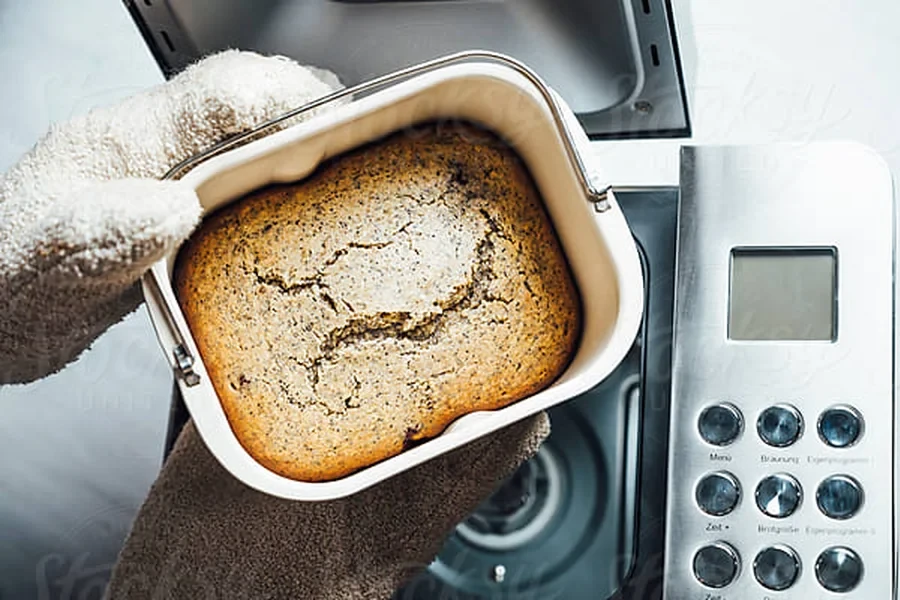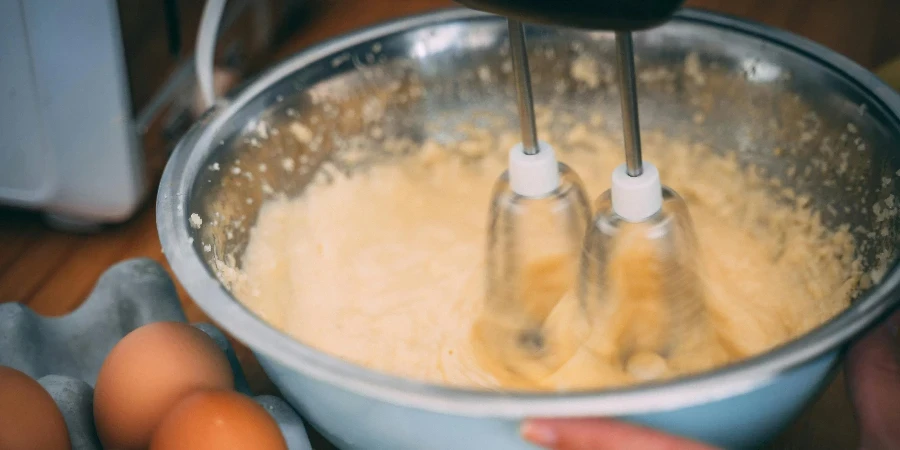The demand for dough makers has surged recently, driven by the rise in home-cooked meals and baking convenience. This article will provide an in-depth analysis of key factors to consider when selecting a dough maker, including type, volume, power, attachments, and maintenance. Professional buyers will find valuable insights to make informed decisions that enhance their operational efficiency.
Sumário:
1. Dough Maker Market Overview
2. In-Depth Market Analysis of Dough Makers
3. Key Factors When Selecting a Dough Maker
4. Understanding the Different Types of Dough Makers
5. Advanced Features in Modern Dough Makers
6. Maintenance and Longevity of Dough Makers
7. A Final Word
Dough Maker Market Overview

The global dough maker market is experiencing significant growth, fueled by the demand for baking convenience and the popularity of home-cooked meals. In 2023, the market was valued at USD 591.9 million and is projected to reach USD 1.01 billion by 2032, with a compound annual growth rate (CAGR) of 6.21% from 2023 to 2032. This growth is driven by technological advancements, the rise of nuclear families, and an increasing working population, all of which boost the demand for automatic dough makers.
The Asia-Pacific region, especially China, Japan, and India, is expected to show the highest growth rates due to rapid urbanization and increasing disposable incomes. North America and Europe also hold substantial market shares, driven by a preference for home-baked goods and a trend towards healthier eating habits. Market segmentation includes product types such as horizontal and vertical dough makers, connectivity options like wired and wireless, and distribution channels including supermarkets, hypermarkets, online stores, and retail stores.
In-Depth Market Analysis of Dough Makers

Automatic dough makers lead the market due to their user-friendly design and advanced features that minimize manual effort. The integration of artificial intelligence (AI) and the Internet of Things (IoT) in these devices has enhanced their functionality, allowing precise control over dough consistency and texture. Leading brands like Panasonic, Breville Group Limited, and Zojirushi Corporation are at the forefront of these innovations, continuously expanding their product portfolios to maintain market share.
Economic factors such as rising disposable incomes and an increasing working population significantly drive market growth. Consumer behavior has shifted towards homemade, preservative-free bread, further fueling the demand for dough makers. Additionally, growing awareness of gluten intolerance and the benefits of gluten-free diets has led to increased adoption of dough makers capable of producing gluten-free dough.
Distribution channel preferences are evolving, with a notable increase in online sales due to the convenience of e-commerce platforms. Supermarkets and hypermarkets remain significant due to their wide reach and ability to offer product demonstrations. Recent innovations include dough makers with multi-functional capabilities, such as making pizza dough and jam, catering to diverse consumer needs.
Key Factors When Selecting a Dough Maker

When selecting a dough maker for your business, several critical factors ensure the equipment meets your specific needs. These include the type of dough, the volume of dough, the machine’s power and capacity, available attachments, and the overall durability and ease of maintenance. Below, we delve into these key factors.
Tipo de Massa
Understanding the type of dough you will be preparing is crucial. Different doughs have varying consistencies and absorption rates, affecting the dough maker’s performance.
Bread Dough typically requires a powerful dough maker with a robust motor to handle the dense consistency. The absorption ratio (the amount of water relative to the amount of flour) is a key factor. For example, a lower absorption ratio means the dough is stiffer and requires more power to mix.
Pizza Dough can vary from light to heavy. Light to medium pizza doughs can be managed by standard-duty mixers, whereas heavy pizza doughs require heavy-duty mixers to ensure thorough mixing and kneading without overloading the motor.
Pastry Dough often requires a more gentle mixing process to avoid overworking the dough. Dough makers with variable speed settings and specific pastry attachments can help achieve the desired consistency without compromising the dough’s quality.
Volume of Dough
The volume of dough you need to prepare will significantly impact the size and capacity of the dough maker you should choose.
For small-scale operations or occasional use, a dough maker with a capacity of 5 to 20 quarts may suffice. These models are often more affordable and take up less space.
For bakeries or pizzerias with higher production needs, dough makers with a capacity of 20 to 60 quarts are more appropriate. These machines can handle larger batches and reduce the frequency of mixing cycles.
For industrial-scale operations, dough makers with capacities exceeding 60 quarts are essential. These heavy-duty machines are designed to operate continuously and handle the demands of large-scale dough production.
Potência e Capacidade
The power and capacity of a dough maker determine its efficiency and suitability for your needs.
Motor Power is a key indicator of a dough maker’s capability. A higher HP motor can handle denser doughs and larger batches without straining. For instance, a 1/2 HP motor may be sufficient for small to medium batches, while a 1 1/2 HP motor is better suited for heavy-duty applications.
Bowl Capacity should align with your production requirements. Note that the bowl should not be filled to the brim, as different ingredient factors can affect the batch size. For example, higher flour protein content, lower water temperature, and less water in the dough all result in smaller batch sizes.
Anexos e acessórios
The versatility of a dough maker can be greatly enhanced by various attachments and accessories.
A Dough Hook is essential for kneading bread and pizza dough, mimicking the kneading process and ensuring even mixing.
A Flat Beater is ideal for mixing batters, frostings, and cookie dough, handling a range of mixing tasks.
A Wire Whip is used for incorporating air into light mixtures such as whipped cream and egg whites, crucial for achieving the desired consistency in these preparations.
A Pastry Knife is specifically designed for blending fats and flour together, perfect for making pie dough and other pastry doughs.
Durabilidade e Manutenção
The durability and ease of maintenance of a dough maker are important considerations for long-term performance and reliability.
High-quality materials such as stainless steel and heavy-duty die-cast housing enhance the durability of the dough maker. These materials are resistant to corrosion and wear, ensuring the machine can withstand daily use.
Regular maintenance is essential to keep the dough maker in optimal condition. This includes cleaning the attachments and accessories after each use, using food-grade machine oil on the attachment shaft, and performing regular oil changes every 6 to 12 months. Additionally, service technicians should perform annual or biannual checks to prevent breakdowns.
Safety features such as bowl guards and interlock systems are crucial to prevent accidents and ensure the operators’ safety. These features should be considered to ensure compliance with safety standards and regulations.
By carefully considering these factors, you can select a dough maker that meets your specific needs and enhances the efficiency and quality of your dough preparation process.
Understanding the Different Types of Dough Makers

Dough makers come in various types, each designed for specific applications and dough types. Understanding the differences can help you choose the right machine for your needs.
Misturadores Planetários
Planetary mixers are versatile and widely used in commercial kitchens. They are named for the way the mixing attachment orbits around the bowl, similar to the way planets orbit the sun.
Planetary mixers can handle a wide range of mixing tasks, from whipping egg whites to kneading dough. They come with various attachments, including dough hooks, flat beaters, and wire whips, making them suitable for different types of dough and batters.
Planetary mixers are available in various capacities, from small countertop models with 5-quart bowls to large floor models with 100-quart bowls. This makes them suitable for both small and large-scale operations.
These mixers typically have multiple speed settings, allowing you to adjust the mixing speed according to the type of dough. Some models also allow for speed changes during operation, enhancing productivity and efficiency.
Misturadores Espirais
Spiral mixers are specifically designed for mixing dough, particularly bread and pizza dough. They feature a spiral-shaped agitator that remains stationary while the bowl revolves around it.
Spiral mixers are known for their ability to mix dough gently and efficiently, ensuring proper gluten development without overworking the dough. This results in a consistent, high-quality dough.
These mixers are ideal for high-volume dough production, with capacities ranging from 20 to over 100 quarts. They are commonly used in bakeries and pizzerias that require large batches of dough.
Spiral mixers are equipped with powerful motors to handle dense doughs. The motor power ranges from 1/2 HP to over 2 HP, depending on the model and capacity.
Vertical Cutter Mixers
Vertical cutter mixers are versatile machines designed for bulk production. They feature a large covered mixing bowl, a high horsepower motor, and an interior agitator.
Vertical cutter mixers can perform a variety of tasks, including chopping, pureeing, mixing, and kneading. They are suitable for preparing sauces, soups, salads, batters, and doughs.
These mixers are designed for fast and efficient mixing, making them ideal for high-volume operations such as food production facilities, dining halls, and cafeterias.
Vertical cutter mixers are built with durable materials and robust components, ensuring long-term reliability and performance.
Advanced Features in Modern Dough Makers

Modern dough makers come with advanced features that enhance their functionality, efficiency, and ease of use. These features can significantly impact the machine’s performance and the dough’s quality.
Controles e displays digitais
Digital controls and displays provide precise control over the mixing process. They allow you to set and monitor the mixing speed, time, and other parameters with ease.
Digital controls enable precise adjustments, ensuring consistent results every time. This is particularly important for recipes that require specific mixing times and speeds.
The intuitive interface of digital displays makes it easy for operators to use the machine, reducing the learning curve and minimizing errors.
Some models come with programmable settings that allow you to save and recall specific mixing parameters for different recipes, enhancing efficiency and consistency.
Características de segurança
Safety features are essential to prevent accidents and ensure the safe operation of the dough maker.
Bowl guards prevent hands, clothing, or foreign objects from coming into contact with the agitator during operation. They are a mandatory safety feature to comply with OSHA regulations.
Interlock systems ensure that the mixer stops operating when the bowl is lowered or the guard is opened. This prevents accidental injuries and enhances safety.
Overload protection features prevent the motor from overheating or becoming damaged due to excessive load. This extends the lifespan of the machine and ensures reliable performance.
Eficiência energética
Energy-efficient dough makers reduce operational costs and minimize environmental impact.
Modern dough makers are equipped with energy-efficient motors that consume less power while delivering high performance. This reduces electricity costs and enhances sustainability.
Variable speed settings allow you to adjust the mixing speed according to the dough type, optimizing energy consumption and improving efficiency.
Some dough makers have a standby mode that reduces power consumption when the machine is not in use. This feature is particularly useful in high-volume operations where the machine is used intermittently.
By understanding the different types of dough makers and their advanced features, you can make an informed decision that meets your specific needs and enhances the efficiency and quality of your dough preparation process.
Maintenance and Longevity of Dough Makers

Proper maintenance is crucial to ensure the longevity and optimal performance of dough makers. Regular care and preventive measures can significantly extend the lifespan of the equipment and reduce the risk of breakdowns.
Limpeza Regular
Consistent cleaning of the dough maker and its components is essential to maintain hygiene and prevent contamination.
Remove and clean attachments and accessories after each use. Most attachments are dishwasher safe, but they can also be washed by hand using warm soapy water.
Use a damp cloth with sanitizer to clean the main part of the dough maker after each use or at the end of every day. Avoid submerging the unit in water to prevent damage to electrical components.
Clean the mixing bowl thoroughly after each use to remove any dough residue. Stainless steel bowls are typically easy to clean and resistant to staining.
Lubrificação
Proper lubrication of the dough maker’s moving parts is essential to prevent wear and tear and ensure smooth operation.
Apply food-grade machine oil to the attachment shaft regularly to minimize friction and reduce the risk of breakage.
Lubricate gears and bearings as per the manufacturer’s recommendations to ensure optimal performance and longevity.
Manutenção preventiva
Regular preventive maintenance can help identify potential issues before they become major problems, ensuring the dough maker operates efficiently and reliably.
Have service agents perform regular oil changes every 6 to 12 months, depending on the frequency of use. This helps maintain the efficiency of the motor and other moving parts.
Schedule annual or biannual checks by service technicians to inspect the dough maker for any signs of wear or damage. This proactive approach can prevent breakdowns and extend the lifespan of the machine.
Treinamento e Segurança
Proper training of staff on the correct use and maintenance of the dough maker is essential to ensure safe and efficient operation.
Train staff on how to operate the dough maker, including how to change attachments, adjust settings, and clean the machine. This helps prevent accidents and ensures consistent results.
Implement safety protocols to ensure that staff understand the importance of using the bowl guard, not bypassing safety features, and following proper cleaning procedures.
Keep a maintenance log to track cleaning, lubrication, and service activities. This helps ensure that maintenance tasks are performed regularly and any issues are addressed promptly.
By following these maintenance practices, you can ensure the longevity and optimal performance of your dough maker, reducing downtime and enhancing the efficiency of your dough preparation process.
Uma Palavra Final
Selecting the right dough maker for your business involves careful consideration of various factors, including the type of dough, volume of production, power and capacity, available attachments, and overall durability and maintenance requirements. By understanding the different types of dough makers and their advanced features, you can make an informed decision that meets your specific needs and enhances the efficiency and quality of your dough preparation process. Regular maintenance and proper training are essential to ensure the longevity and optimal performance of the dough maker, reducing downtime and enhancing productivity.




